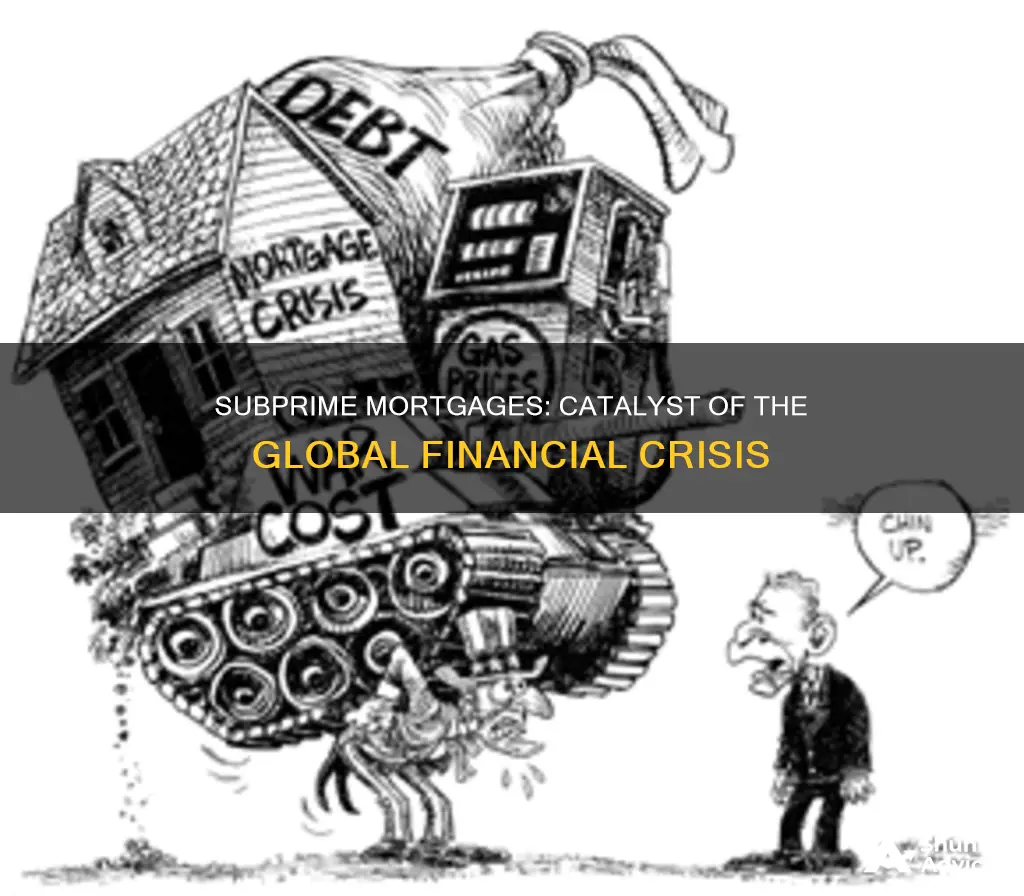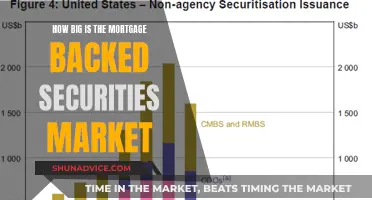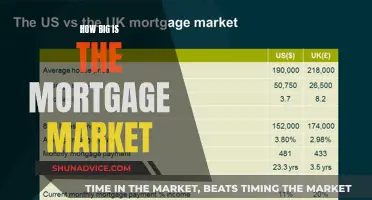
The global financial crisis of 2007–2009, also known as the Great Recession, was triggered by the collapse of the United States housing market bubble and the subsequent default of a large number of subprime mortgages in the USA. Subprime mortgages are loans given to borrowers with low credit scores, and the rise in their availability and demand in the early to mid-2000s led to a housing bubble, as house prices rose rapidly. This was further exacerbated by the creation and trade of complex financial derivatives tied to the real estate sector, which were often backed by high-risk assets. When the bubble burst, it led to a severe economic recession, with millions losing their jobs and many businesses going bankrupt. The crisis was characterised by mass foreclosures, a decline in house prices, and a reduction in consumer spending and lending capabilities.
| Characteristics | Values |
|---|---|
| Date | 2007-2010 |
| Location | USA |
| Causes | Rise in subprime lending, increase in housing speculation, lowered lending standards, higher-risk mortgage products, excessive leverage, misplaced confidence in the housing market, demand outstripping supply, financial derivatives, high-interest rates |
| Effects | Severe economic recession, job losses, business bankruptcies, mass foreclosures, devaluation of housing-related securities, decline in construction, reduced consumer spending, decreased lending ability of financial firms, reduced ability of firms to raise funds from securities markets |
| Government Response | Troubled Asset Relief Program (TARP), American Recovery and Reinvestment Act (ARRA), interest rate cuts, large-scale asset purchase (LSAP) programs |
What You'll Learn

The rise in subprime lending
In the early to mid-2000s, there was a notable shift in lending behaviour, with lenders offering more loans to these higher-risk borrowers. This was a departure from traditional lending standards and was driven by the expansion of mortgage credit and the repackaging of loans into pools or securities that could be sold to investors. This practice, known as securitization, allowed lenders to spread the risk of default across multiple investors and encouraged more lending to high-risk borrowers. The government-sponsored enterprise (GSE) mortgage market share declined during this period, with private securitizers filling the gap.
The availability of subprime mortgages fuelled a housing boom as more first-time homebuyers entered the market, driving up demand and house prices. This created a self-reinforcing cycle, with rising house prices further stimulating demand as buyers expected prices to continue increasing. The expansion of mortgage credit and the belief that housing prices would continue to rise led to a surge in speculative borrowing and contributed to the formation of a financial bubble.
As the crisis unfolded, many borrowers with subprime mortgages began to miss their repayments as interest rates climbed, leading to mass delinquencies and foreclosures. This, in turn, fuelled a downward spiral in house prices, unwinding the gains made during the boom and exacerbating the financial turmoil. The collapse of the housing bubble and the subsequent credit crunch disrupted financial markets globally, leading to the severe economic recession of 2007-2009.
Prepaying Your Mortgage: How Common Is It?
You may want to see also

The increase in housing speculation
The availability of high-risk mortgages was facilitated by the creation of new financial products, such as private-label mortgage-backed securities (PMBS) and collateralized debt obligations (CDOs). These financial instruments were used to apportion risk and provided funding for subprime mortgages. The belief that housing prices would continue to rise indefinitely fuelled speculative bubbles, with investors taking on more leverage and contributing to higher rates of default when the market eventually turned.
In the lead-up to the crisis, nearly 40% of homes purchased were not intended as primary residences. This shift in behaviour, treating homes as speculative investments rather than primary residences, contributed to the housing bubble. As a result, housing prices nearly doubled between 2000 and 2006, far outpacing the historical appreciation rate of inflation. The excessive number of houses constructed during this period further exacerbated the imbalance between supply and demand.
When housing prices peaked and began to decline, the impact on the overall economy was significant. Lower construction rates, reduced wealth, decreased consumer spending, and impaired ability of financial firms to lend or raise funds from securities markets all contributed to the recession. The collapse of subprime lending led to a downward spiral in house prices, fuelling expectations of further declines and reducing demand for homes. Ultimately, the increase in housing speculation played a crucial role in triggering the global financial crisis, causing widespread economic disruption and impacting millions of people worldwide.
Mortgage Business: A Giant Industry Overview
You may want to see also

The creation and trade of complex financial derivatives
One type of derivative that contributed to the crisis was credit default swaps (CDS). CDS are financial instruments used as a hedge or protection for debtholders, especially MBS investors, from the risk of default. As the net worth of banks and other financial institutions declined due to losses related to subprime mortgages, the likelihood increased that those providing protection would have to pay their counterparties. This dynamic created uncertainty across the financial system. The volume of CDS outstanding increased exponentially from 1998 to 2008, with estimates of the debt covered by CDS contracts in the tens of trillions of dollars.
Another type of derivative that contributed to the crisis was collateralized debt obligations (CDOs). CDOs are complex instruments that allowed for multiple bets on the same securities, amplifying the losses from the collapse of the housing bubble. Companies selling protection on CDOs, such as AIG, did not set aside sufficient capital to cover their obligations when significant defaults occurred. The lack of trading on exchanges made it difficult to measure the obligations of key financial institutions, further contributing to uncertainty in the financial system.
Mortgage-backed securities (MBSes) were also a type of derivative that played a role in the crisis. MBSes were backed by high-risk assets, including subprime mortgages, and their behavior was often poorly predicted. As the crisis unfolded, MBS investors faced significant losses, contributing to the overall instability of the financial system.
The creation and trade of these complex financial derivatives, combined with excessive leverage and misplaced confidence in the housing market, were significant contributors to the subprime mortgage crisis. The total value of derivatives exceeded the global GDP by more than tenfold, indicating the staggering volume and impact of these instruments on the global economy.
Notarizing Mortgage Documents: The California Notary's Role
You may want to see also

The decline in lending standards
This decline in lending standards was driven by various factors. One significant factor was the growth of the market for mortgage-backed securities (MBS) and collateralized debt obligations (CDO). Lenders were able to repackage the loans into securities, which were then sold to investors, reducing the risk for lenders and incentivizing them to offer more loans. Additionally, the government-sponsored enterprise (GSE) mortgage market share declined, while the share of private securitizers, such as Fannie Mae and Freddie Mac, increased, leading to a rise in non-prime mortgages.
The availability of high-risk mortgages fuelled a surge in demand for housing. This, coupled with rising house prices, created a housing bubble. The belief that housing prices would continue to increase led to further speculation and investment in the real estate market. However, as the bubble burst and house prices began to fall, many borrowers found themselves unable to keep up with their mortgage repayments, leading to a wave of defaults and delinquencies.
Matthew Cox's Mortgage Swindle: How Did He Do It?
You may want to see also

The role of government housing policies
Government-sponsored enterprises (GSEs), such as Fannie Mae and Freddie Mac, played a role in the expansion of subprime lending. While some argue that they contributed to the crisis, others assert that they followed rather than led Wall Street and other lenders into subprime lending. The GSE mortgage securities maintained their value throughout the crisis, indicating that they were not a primary cause of significant financial firm losses.
The unregulated creation and trade of derivatives, particularly in the unregulated OTC markets, further compounded the instability of the financial system. These derivatives were often tied to the real estate sector and lacked transparency, making their behaviour difficult to predict. The sheer volume of these derivatives, backed by high-risk assets, created a fragile financial structure that was bound to collapse.
The collapse of the US housing bubble and the subsequent increase in interest rates led to an unprecedented number of borrowers defaulting on their mortgage repayments. This resulted in mass foreclosures and the devaluation of housing-related securities. The downward spiral in house prices and the overall economic damage prompted the US government to intervene with measures such as the Troubled Asset Relief Program (TARP) and the American Recovery and Reinvestment Act (ARRA).
Mortgage Servicing Transfers: A Common Occurrence for Homeowners
You may want to see also
Frequently asked questions
Subprime mortgages are loans given to borrowers with low credit scores.
The crisis was caused by a combination of factors, including the rise in subprime lending, an increase in housing speculation, and the collapse of the United States housing bubble.
The crisis led to a severe economic recession, with many people losing their jobs and businesses going bankrupt. It also caused a decline in house prices, which hurt the overall economy and reduced the ability of financial firms to lend money.
The crisis originated in the USA but quickly spread to other countries through financial linkages. For example, European banks that had invested in US subprime mortgage-backed securities suffered significant losses.
The crisis led to a loss of confidence in the financial system and a tightening of credit lines worldwide. It also resulted in a downward spiral of asset prices, with banks and financial institutions forced to sell assets to reduce their balance sheets.







